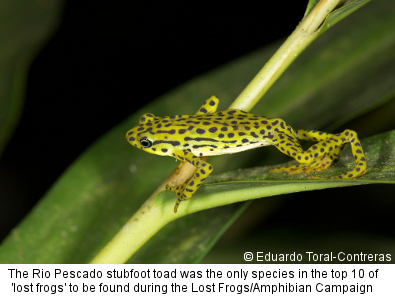During August and December 2010 Conservation International (CI), in collaboration with the IUCN Amphibian Specialist Group (ASG) and Global Wildlife Conservation (GWC), supported expeditions to 21 different countries across 5 continents to find amphibian species that have not been seen in the past decade or more.
Just four species on Conservation International’s Top 100 list of ‘Lost Frogs’ were found, including an EDGE species called the cave splayfoot salamander (Chiropterotriton mosaueri) which had not been seen for almost 70 years!
Remarkably, another EDGE amphibian was found in the same cave, the bigfoot splayfoot salamander (Chiropterotriton magnipes). Dr. Sean Rovito who found the salamanders said ”I felt tremendously lucky not only to have found these magnificent salamanders, but also to know that both of these species persist in the wild after so many years.”
Of the Top 100 ‘lost frogs’ that Conservation International hoped to find, the Rio Pescado stubfoot toad (Atelopus balios) was the only species in the top 10 of the list to be found. The Rio Pescador stubfoot toad was rediscovered in Ecuador after not being seen for 15 years! It was feared that this species had been wiped out by chytrid fungus, which has caused the extinction of other closely related species, and so this finding has been very encouraging.
Last seen in 1874 (that’s 136 years ago!) the beautiful Chalazodes bubble-nest frog (Raorchestes chalazodes) was rediscovered in India. This frog has ash-blue thighs and black pupils with golden patches, which is unusual among amphibians. Bubble-nest frogs make nests out of foam which protects the eggs developing inside and keeps them hydrated. The eggs of the Chalazodes bubble-nest frog are thought to develop directly into the adult form, skipping the free-swimming tadpole stage.
In total, CI’s “Lost Frogs” campaign rediscovered 15 amphibian species across the world, and three potentially new species of frog were discovered in Colombia. One potential new species is thought to belong to the Rocket frog genus Siverstonia. A type of poison dart frog this frog carries newly hatched tadpoles on its back to water where they are able to develop into adults.
The rediscovery of these species is an important step in the conservation of amphibians. Almost half of all known amphibian species are in decline and at least 1 in 3 amphibian species is threatened with extinction. Threats to amphibians include habitat destruction, disease, climate change, pollution, invasive species and over-exploitation for the food and pet trades. Amphibians are particularly sensitive to environmental changes and this can lead to extinctions, especially when populations are small or confined to a small, isolated area. Diseases, in particular chytridiomycosis and Ranavirus, have led to serious population declines in many species and have probably caused a number of extinctions to date. In the future climate change will become an increasing threat to amphibian populations as changing environmental conditions impact breeding behaviour, habitats, disease threats and a number of other factors crucial to the wellbeing of surviving species.
To find out more about Conservation International and their search for lost frogs visit their website which has all the expedition results and some fabulous pictures of the rediscovered frogs.
If you would like to find out how you can get involved in the conservation of amphibians in your own garden and local area, please visit the ‘How to get involved page’ on the EDGE website. You can help support conservation action for threatened amphibians through EDGE.



